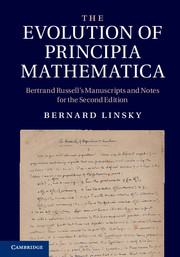 The Evolution of Principia Mathematica
The Evolution of Principia Mathematica Book contents
- Frontmatter
- Contents
- 1 Introduction
- 2 Writing the second edition
- 3 Logic since the first edition
- 4 Notation and logic
- 5 Improvements in the new edition
- 6 Induction and types in Appendix B
- 7 The reception of the second edition
- 8 The list of definitions for Carnap
- Introduction to the second edition
- Appendix A
- Appendix B
- Appendix C
- Hierarchy of propositions and functions
- Amended list of propositions: notes
- Bibliography
- Index
- Plate section
6 - Induction and types in Appendix B
Published online by Cambridge University Press: 05 August 2011
- Frontmatter
- Contents
- 1 Introduction
- 2 Writing the second edition
- 3 Logic since the first edition
- 4 Notation and logic
- 5 Improvements in the new edition
- 6 Induction and types in Appendix B
- 7 The reception of the second edition
- 8 The list of definitions for Carnap
- Introduction to the second edition
- Appendix A
- Appendix B
- Appendix C
- Hierarchy of propositions and functions
- Amended list of propositions: notes
- Bibliography
- Index
- Plate section
Summary
Induction and inductive classes
The topic of Appendix B is the principle of mathematical induction which, together with the definition of numbers as classes of equinumerous classes, forms the heart of the logicist account of arithmetic. Throughout the earlier history of mathematics, induction had been recognized as a method of proof distinctive of arithmetic. The great achievement of the logicists, in particular, of Frege, was to show how induction could be shown to follow from logical truths and definitions alone.
The principle of induction is used to show that a property holds of all numbers by first showing that it holds of 0 and then that if it holds for some arbitrary n then it holds for n + 1. Proofs “by induction” thus have two parts. The first, “basis step” for the induction, is to prove that the given property holds of 0. The second, “induction step”, proceeds by assuming that the property holds of an arbitrary number n, the so-called “inductive hypothesis”, and then showing that it holds for n + 1. These two together suffice for proving that the property holds of all numbers.
Induction is not at the heart of the development of mathematics in Principia Mathematica, nor even that of Frege's earlier Grundgesetze der Arithmetik (1893). By the time of Introduction to Mathematical Philosophy (IMP) in 1919, however, Russell had come to present it as a central part of what is now the standard account of how mathematics emerges from logic.
- Type
- Chapter
- Information
- The Evolution of Principia MathematicaBertrand Russell's Manuscripts and Notes for the Second Edition, pp. 138 - 169Publisher: Cambridge University PressPrint publication year: 2011


